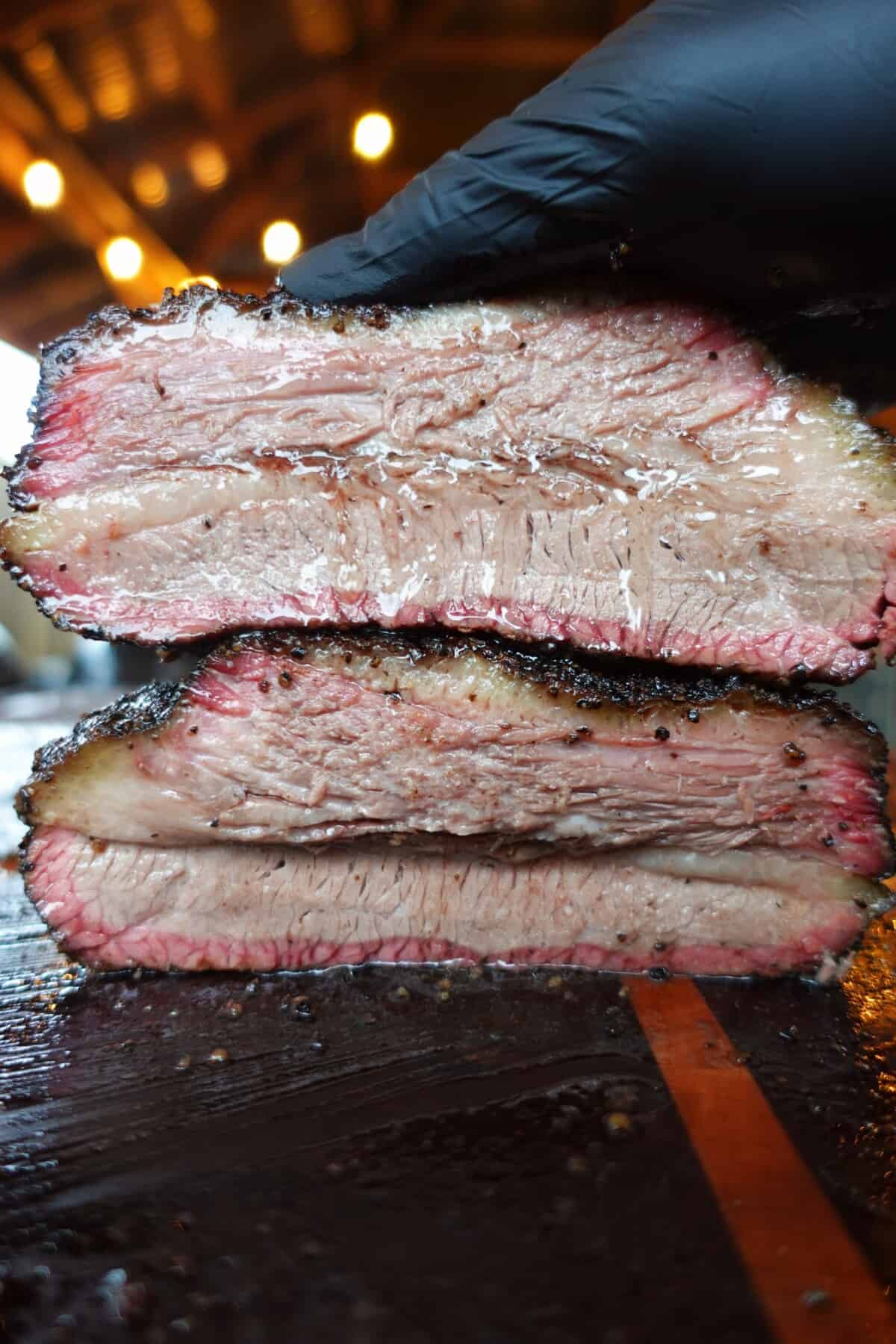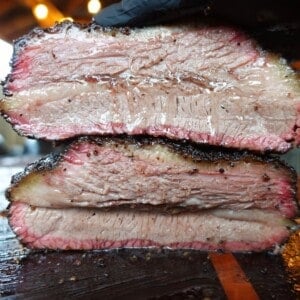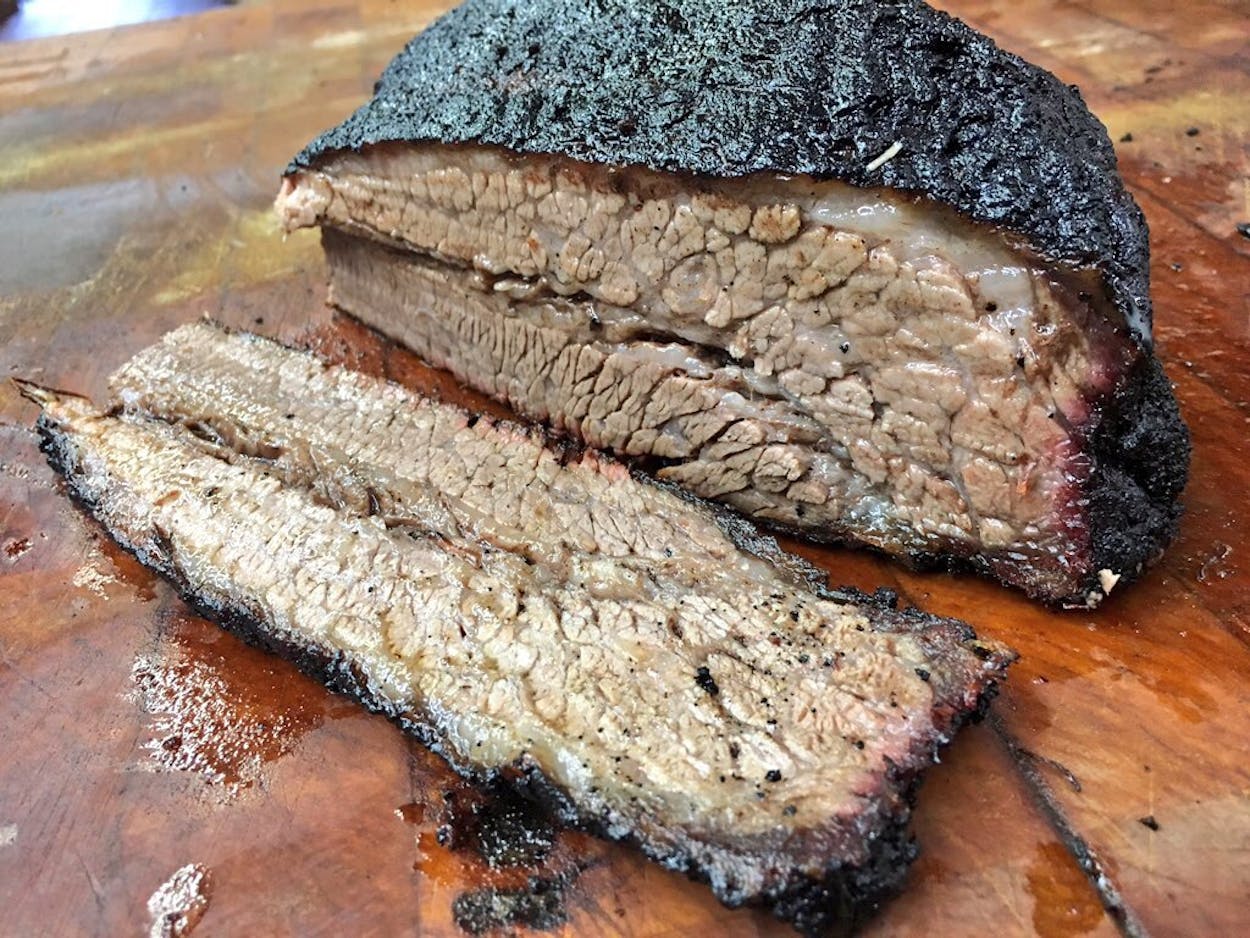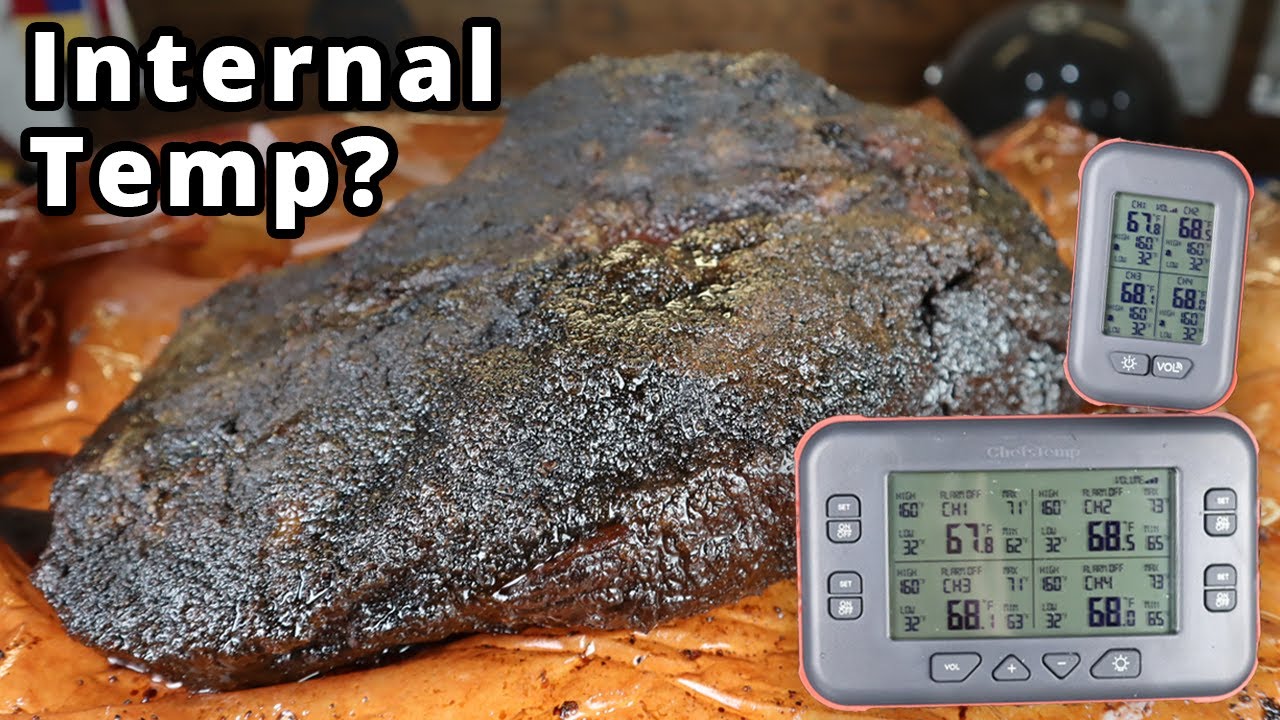Factors Affecting Brisket Doneness

Achieving the ideal doneness of a brisket is influenced by various factors. One crucial factor is the size and thickness of the brisket. Thicker cuts will require a longer cooking time to reach the desired internal temperature. Additionally, the cooking method and equipment used can also affect the doneness. Smokers or grills with inconsistent heat may result in uneven cooking. The marbling and quality of the meat can also impact doneness, as better-quality meat tends to cook more evenly. Lastly, external factors such as weather conditions and altitude may affect the cooking time and overall doneness of the brisket.
Factors To Consider When Determining Brisket Doneness
When determining the doneness of brisket, there are several factors to consider. One important factor is the size and thickness of the brisket. Thicker cuts will require a longer cooking time to reach the desired internal temperature. The cooking method and equipment used can also affect the doneness, with smokers or grills with inconsistent heat resulting in uneven cooking. Additionally, the marbling and quality of the meat can impact doneness, as better-quality meat tends to cook more evenly. Lastly, external factors such as weather conditions and altitude may also affect the cooking time and overall doneness of the brisket.
The Importance Of Temperature In Achieving The Ideal Brisket Doneness
Temperature plays a crucial role in achieving the ideal brisket doneness. Cooking the brisket to the right internal temperature ensures that it is tender and flavorful. If the temperature is too low, the meat will be undercooked and tough. On the other hand, if the temperature is too high, the meat will be overcooked and dry. The ideal internal temperature range for pulling brisket off the smoker is between 190°F to 203°F (88°C to 95°C), with 195°F (90°C) being the recommended temperature. This ensures a juicy and tender brisket that is perfect for serving.
Ideal Brisket Temperature Range

The ideal brisket temperature range for pulling the meat off the smoker is between 190°F to 203°F (88°C to 95°C), with 195°F (90°C) being the recommended temperature. This temperature range ensures that the brisket is cooked to perfection, resulting in a tender and flavorful meat. It allows for the connective tissues to break down and the fat to render properly, creating a juicy and delicious brisket. By cooking the brisket within this temperature range, you can ensure that it is not undercooked or overcooked, but perfectly done and ready to be enjoyed.
Recommended Temperature Range For Pulling Brisket
The recommended temperature range for pulling brisket is between 190°F to 203°F (88°C to 95°C), with 195°F (90°C) being the ideal temperature. This range ensures that the brisket is cooked to perfection, with the connective tissues broken down and the fat rendered properly. At 195°F, the brisket will be tender and flavorful, making it easy to slice and enjoy. It is important to use a meat thermometer to accurately monitor the internal temperature of the brisket and ensure it reaches the desired range for optimal doneness.
Understanding The Different Levels Of Doneness Based On Temperature
To determine the doneness of a brisket based on temperature, it’s essential to understand the different levels of doneness. Here are the common levels:
- Rare (130°F to 140°F / 54°C to 60°C): At this temperature, the brisket will have a bright red center and be extremely rare. It will be very tender but may lack the desired flavor and texture.
- Medium Rare (140°F to 145°F / 60°C to 63°C): This is the preferred doneness for many BBQ enthusiasts. The brisket will have a pink center with a slightly firmer texture. It will be juicy, tender, and have a good balance of flavors.
- Medium (145°F to 155°F / 63°C to 68°C): At this temperature, the brisket will have a more pronounced pink center and a firmer texture. It will still be juicy and flavorful, but not as tender as medium-rare.
- Well Done (155°F and above / 68°C and above): Brisket cooked to well done will have a fully cooked center with little to no pink. It will have a firmer texture and may be slightly drier compared to the other levels of doneness.
The ideal level of doneness depends on personal preference. However, it’s important not to overcook the brisket as it may result in dry and tough meat. It’s best to aim for medium-rare to medium doneness for the juiciest and most flavorful results.
Using A Meat Thermometer For Accuracy

Using a meat thermometer is an essential tool for achieving accurate and consistent results when cooking brisket. It allows you to monitor the internal temperature of the meat, ensuring that it reaches the desired level of doneness without overcooking or undercooking. By inserting the probe into the thickest part of the brisket, you can accurately measure the temperature and ensure that it is cooked to perfection. This reliable method takes the guesswork out of cooking, allowing you to serve juicy and flavorful brisket every time. So invest in a good quality meat thermometer and elevate your brisket cooking game.
The Benefits Of Using A Meat Thermometer When Cooking Brisket
Using a meat thermometer when cooking brisket brings several benefits. Firstly, it ensures accuracy in determining the internal temperature of the meat, leading to consistent and perfect cooking results every time. This prevents undercooked or overcooked brisket, resulting in a tender and juicy texture. Secondly, it eliminates guesswork and reduces the risk of foodborne illnesses by ensuring the meat reaches a safe temperature. Additionally, using a meat thermometer allows for precise monitoring of the cooking process, enabling you to achieve your desired level of doneness. Overall, a meat thermometer is an invaluable tool for achieving optimal results when cooking brisket.
How To Properly Use A Meat Thermometer To Check Brisket Temperature
To properly use a meat thermometer to check the temperature of your brisket, follow these steps:
- Insert the thermometer probe into the thickest part of the brisket, avoiding any bones or fat.
- Make sure the probe reaches the center of the meat without touching the other side.
- Wait for a few seconds until the thermometer gives an accurate reading.
- If using a digital thermometer, make sure to read the temperature on the display.
- Take note of the temperature and compare it to the recommended range for brisket doneness.
- Repeat the process in different parts of the brisket to ensure consistent cooking throughout.
Using a meat thermometer will ensure precise readings and help you achieve the perfect level of doneness for your brisket.
Resting Period After Cooking Brisket

Resting is a crucial step in the brisket cooking process. After cooking, it is important to let the brisket rest before slicing it. This allows the juices to redistribute throughout the meat, ensuring a juicy and flavorful result. The recommended resting time for brisket is a minimum of 30 minutes, up to around two hours. During this time, you can tent the brisket with foil to keep it warm. Resting allows the brisket to reach its optimal tenderness and makes it easier to slice. Patience during the resting period will be rewarded with a delicious and satisfying brisket.
The Significance Of Letting Brisket Rest Before Slicing
Letting brisket rest before slicing is a crucial step in achieving a delicious and tender result. During the resting period, the meat continues to cook as the residual heat spreads evenly throughout the brisket. This allows the juices to redistribute, resulting in a more flavorful and moist brisket. Additionally, resting allows the muscle fibers to relax, making it easier to slice the brisket against the grain, further enhancing its tenderness. By giving the brisket ample time to rest, you ensure that each slice is juicy, tender, and bursting with flavor.
Optimal Resting Time For Juicy And Flavorful Brisket
After cooking, it is crucial to let the brisket rest before slicing to achieve optimal juiciness and flavor. The recommended resting time for a brisket is around 1 to 2 hours. During this period, the meat continues to cook, allowing the residual heat to distribute evenly and the juices to redistribute throughout the brisket. This resting process enables the muscle fibers to relax, resulting in a more tender and succulent texture. By allowing the brisket to rest adequately, you can ensure that each slice is moist, flavorful, and truly irresistible.
Slicing And Serving Brisket

Proper techniques for slicing brisket involve cutting against the grain to ensure tenderness. Start by identifying the grain direction and then slice the brisket into thin, even slices using a sharp knife. Serve the brisket with a side of barbecue sauce or au jus to enhance its flavor. To maintain its tenderness and flavor, keep the sliced brisket warm by placing it in a covered dish or foil wrap. Serve immediately to enjoy the juicy and flavorful results of your perfectly cooked brisket.
Proper Techniques For Slicing Brisket
When it comes to slicing brisket, it is important to use proper techniques to ensure tenderness and presentation. Begin by identifying the direction of the grain in the meat. Then, using a sharp knife, slice the brisket against the grain into thin, even slices. This helps to break up the muscle fibers and maximize tenderness. Be sure to maintain a steady hand and apply gentle pressure when slicing to avoid tearing the meat. Serve the sliced brisket immediately to enjoy its juicy and flavorful results.
Tips For Serving Brisket To Maintain Its Tenderness And Flavor
When serving brisket, there are a few tips to keep in mind to maintain its tenderness and flavor.
- Slice the brisket against the grain to maximize tenderness.
- Serve the brisket immediately after slicing to prevent it from drying out.
- Keep the brisket warm by serving it on a preheated platter or using a warming tray.
- Offer a variety of BBQ sauces and condiments to enhance the flavor of the brisket.
- Pair the brisket with tasty sides such as coleslaw, baked beans, or cornbread to complete the meal. By following these tips, you can ensure that your brisket remains juicy, tender, and flavorful when served.
Conclusion

In conclusion, determining the ideal doneness of brisket is crucial for achieving a delicious and tender result. By considering factors such as temperature and using a meat thermometer, you can ensure that your brisket is cooked to perfection. Allowing the brisket to rest before slicing is also key to ensuring a juicy and flavorful outcome. By mastering the art of slicing and serving brisket, you can fully enjoy its tenderness and flavor. Remember to follow these guidelines and experiment with different techniques to become a brisket cooking expert.
Summary Of Key Points For Achieving Ideal Brisket Doneness
Achieving the ideal brisket doneness requires considering factors such as temperature and using a meat thermometer for accuracy. The recommended temperature range for pulling brisket is between 195°F and 205°F. Understanding the different levels of doneness based on temperature, such as the “probe tender” stage, is essential. Using a meat thermometer ensures that the brisket is cooked to perfection. Allowing the brisket to rest before slicing is crucial for a juicy and flavorful outcome. Proper techniques for slicing and serving brisket maintain its tenderness and flavor. By following these guidelines, you can become a brisket cooking expert.
Next Steps For Mastering The Art Of Cooking Brisket
Once you have a good understanding of the factors that affect brisket doneness and the ideal temperature range for pulling brisket, the next steps towards mastering the art of cooking brisket involve practice and honing your skills. One important step is experimenting with different cooking methods, such as using different types of smokers or grills. You can also try out different rubs, marinades, and wood chips to enhance the flavor profile of your brisket. Additionally, learning from experienced pitmasters or attending BBQ workshops can provide valuable insights and tips. With dedication and persistence, you will continue to improve your brisket cooking technique and create mouthwatering, tender, and flavorful briskets every time.
FAQ About Determining Ideal Brisket Doneness
Q: What is the ideal temperature to pull brisket for the perfect doneness?
A: The ideal internal temperature to pull brisket for optimal tenderness and flavor is around 195-205°F (90-96°C).
Q: How can one determine if brisket is done cooking?
A: To determine if the brisket is done, you can perform a “probe test” where a meat thermometer should slide into the brisket with little to no resistance, or wiggle a probe or skewer in the meat to ensure it feels tender.
Q: Is resting the brisket after cooking necessary?
A: Yes, resting the brisket for at least 30 minutes after cooking is crucial as it allows the juices to redistribute within the meat, ensuring a juicier end result.
Q: What happens if brisket is pulled too early?
A: Pulling the brisket too early can result in tough and chewy meat as the collagen hasn’t fully broken down yet, leading to a less enjoyable eating experience.
Q: Can brisket be overcooked?
A: Yes, brisket can become overcooked if it reaches internal temperatures beyond 210°F (98°C), leading to dry and stringy meat. It’s essential to monitor the cooking process closely to avoid overcooking.

Stutts House of Barbecue is a haven for BBQ enthusiasts, offering a delectable array of smoked delicacies, including ribs, beef, bologna, and chicken, accompanied by all the trimmings you could ever dream of. Our passion for perfecting the art of smoking meats shines through in every savoury bite. At Stutts House of Barbecue, we take pride in our custom smoking techniques, ensuring that each piece of meat is infused with the perfect blend of smoky flavours. But it doesn’t stop there – our homemade desserts are the cherry on top of a delicious meal, adding a sweet finish to your BBQ experience.